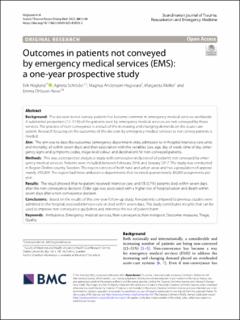| dc.contributor.author | Höglund, Erik | |
| dc.contributor.author | Schröder, Ingrid Agneta | |
| dc.contributor.author | Andersson-Hagiwara, Magnus | |
| dc.contributor.author | Möller, Margareta | |
| dc.contributor.author | Ohlsson-Nevo, Emma | |
| dc.date.accessioned | 2023-01-26T09:45:43Z | |
| dc.date.available | 2023-01-26T09:45:43Z | |
| dc.date.created | 2022-09-15T09:52:20Z | |
| dc.date.issued | 2022 | |
| dc.identifier.citation | Scandinavian Journal of Trauma, Resuscitation and Emergency Medicine. 2022, 30 (1), . | en_US |
| dc.identifier.issn | 1757-7241 | |
| dc.identifier.uri | https://hdl.handle.net/11250/3046493 | |
| dc.description.abstract | Background
The decision to not convey patients has become common in emergency medical services worldwide. A substantial proportion (12–51%) of the patients seen by emergency medical services are not conveyed by those services. The practice of non-conveyance is a result of the increasing and changing demands on the acute care system. Research focusing on the outcomes of the decision by emergency medical services to not convey patients is needed.
Aim
The aim was to describe outcomes (emergency department visits, admission to in-hospital intensive care units and mortality, all within seven days) and their association with the variables (sex, age, day of week, time of day, emergency signs and symptoms codes, triage level colour, and destination) for non-conveyed patients.
Methods
This was a prospective analytical study with consecutive inclusion of all patients not conveyed by emergency medical services. Patients were included between February 2016 and January 2017. The study was conducted in Region Örebro county, Sweden. The region consists of both rural and urban areas and has a population of approximately 295,000. The region had three ambulance departments that received approximately 30,000 assignments per year.
Results
The result showed that no patient received intensive care, and 18 (0.7%) patients died within seven days after the non-conveyance decision. Older age was associated with a higher risk of hospitalisation and death within seven days after a non-conveyance decision.
Conclusions
Based on the results of this one-year follow-up study, few patients compared to previous studies were admitted to the hospital, received intensive care or died within seven days. This study contributes insights that can be used to improve non-conveyance guidelines and minimise the risk of patient harm. | en_US |
| dc.language.iso | eng | en_US |
| dc.publisher | BMC | en_US |
| dc.rights | Navngivelse 4.0 Internasjonal | * |
| dc.rights.uri | http://creativecommons.org/licenses/by/4.0/deed.no | * |
| dc.title | Outcomes in patients not conveyed by emergency medical services (EMS): a one-year prospective study | en_US |
| dc.title.alternative | Outcomes in patients not conveyed by emergency medical services (EMS): a one-year prospective study | en_US |
| dc.type | Peer reviewed | en_US |
| dc.type | Journal article | en_US |
| dc.description.version | publishedVersion | en_US |
| dc.source.pagenumber | 10 | en_US |
| dc.source.volume | 30 | en_US |
| dc.source.journal | Scandinavian Journal of Trauma, Resuscitation and Emergency Medicine | en_US |
| dc.source.issue | 1 | en_US |
| dc.identifier.doi | 10.1186/s13049-022-01023-3 | |
| dc.identifier.cristin | 2051889 | |
| cristin.ispublished | true | |
| cristin.fulltext | original | |
| cristin.qualitycode | 1 | |

